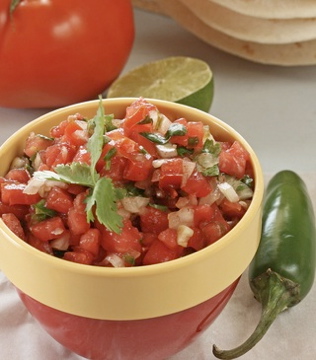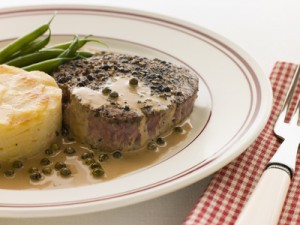Oh joy! It’s midsummer and tomatoes are in season.
Real, juicy, red, luscious, sweet tomatoes that burst with flavor in your mouth–not those mushy, pallid ones from a hothouse.
If you are lucky, you may be able to pick your own fresh tomatoes red and ripe, from your backyard, or have a friend or neighbor supplying you with those warm, juicy red globes. If not, head to your local farmer’s market or look for “locally grown” in your favorite supermarket.
Tomatoes ripen in the sun, but if picked a bit early, they will continue to ripen if you leave them out on your counter top or windowsill. Refrigerating tomatoes not only stops their ripening process, but it also lessens their sweet and tangy flavor.
What to do with this bounty of nature? If you’re tiring of just sliced tomatoes with a drizzle of olive oil, fresh basil, sea salt and pepper, here are some other delicious ways to enjoy these antioxidant rich, cancer fighting, heart health enriching phytonutrients.
Tomatoes are full of antioxidants, vitamins and minerals, especially potassium. And they contain powerful bioflavinoids, which counteract inflammation, allergic reactions, fight cancer and protect your heart. Eating tomatoes will substantially reduce your risk of:
- ovarian cancer
- digestive tract cancers (mouth, throat, esophagus, pancreas, colon and rectum)
- heart disease
- asthma and COPD
- prostate cancer
American men who ate tomatoes (in one study), had a 40 percent reduction in the risk of prostate cancer. Studies of men newly diagnosed with prostate cancer found that increasing consumption of tomato products was associated with a marked decrease in cancer progression.
And it isn’t just the red color that makes tomatoes so healthy for you. Tomatoes of any color: red, green, orange, yellow or purple are all spectacular for your health.
Easy Baked Tomatoes Parmesan
Ingredients
- 4 medium sized tomatoes, cut in half
- 1/4 cup freshly grated Parmesan cheese
- 1 teaspoon chopped fresh oregano, basil or thyme in any combination
- 1/4 teaspoon sea salt
- Freshly ground pepper, to taste
- 4 teaspoons extra-virgin olive oil
Directions
Preheat oven to 450° F.
Place tomatoes cut-side up on a baking sheet. Top with Parmesan, oregano, salt and pepper. Drizzle with oil and bake until the tomatoes are tender, about 10-12 minutes.
Tomato and Watermelon Salad
Ingredients
- 3 or 4 small to medium tomatoes, in assorted colors, cored and cut into 3/4-inch chunks
- 1 small cucumber, peeled, seeded, and cut into 3/4-inch cubes
- 2 cups 3/4-inch-cubed yellow or red seedless watermelon flesh
- 1 tablespoon chopped mixed fresh herbs, in any combination: basil, tarragon, chives, and cilantro
- 1/4 teaspoon coriander seed
- 3 tablespoons extra virgin olive oil
- 3 tablespoons aged balsamic vinegar
- Kosher salt and freshly ground black pepper
Directions
In a bowl, combine the tomatoes, cucumber, watermelon, and herbs.
In a spice grinder, grind the coriander seeds to a fine powder. Add the ground coriander to the tomato mixture and toss gently. In a small bowl, whisk together the olive oil, balsamic vinegar, and salt and pepper to taste. Combine dressing with vegetable/watermelon mixture and refrigerate, allowing flavors to mix for an hour or so.
My Favorite Tomato Salsa
Ingredients
- 4-6 fresh, ripe tomatoes, depending on size, chopped in small pieces
- ½ red onion, minced
- 2 garlic cloves, minced
- 1 or more jalapeño pepper, ribs and seeds removed, and minced finely
- 1 organic or locally grown green or red bell pepper, chopped in small pieces
- 2-4 tomatillos, chopped
- 1 big bunch of cilantro, finely chopped
- Juice of one lemon or lime
- Sea salt
- Teaspoon of sugar
Directions
There are two ways to make this salsa. One method is the chunky version. Just chop all the ingredients by hand with a sharp knife, and mix together with lemon or lime juice and sea salt. You can make it extra chunky or use a finer chop.
For a smoother, more pureed version, coarsely chop the veggies and place in a food processor to mix. Process just enough so mixture is smooth, with no large chunks and serve. This will produce a slightly juicier version, so drain off some of the excess juice with a colander. Add lemon, lime and salt after draining liquid.
Either way, you will enjoy it immensely! Serve with chicken, fish, chips, tacos or on your scrambled eggs. Serves 4 or more.
Enjoy tomatoes while you can, because soon enough tomato season will be over.
Now, what to do with all that zucchini? Stay tuned… 🙂
Till next time,
Stay Healthy and Lean!
 Catherine (Cat) Ebeling RN BSN, is a back to basics diet and nutrition specialist. In addition to her advanced degree in nursing from a major medical school, she has spent the last 30 years intensely studying diet, health and nutrition. She also has a book titled “The Fat Burning Kitchen, Your 24 Hour Diet Transformation” that has sold over 60,000 copies worldwide, and has helped thousands of people transform their lives, lose weight and improve their health.
Catherine (Cat) Ebeling RN BSN, is a back to basics diet and nutrition specialist. In addition to her advanced degree in nursing from a major medical school, she has spent the last 30 years intensely studying diet, health and nutrition. She also has a book titled “The Fat Burning Kitchen, Your 24 Hour Diet Transformation” that has sold over 60,000 copies worldwide, and has helped thousands of people transform their lives, lose weight and improve their health.
Her mission is to help others prevent disease and live their best life ever.
Nutrition made Easy. Simple.Smart.Nutrition.


